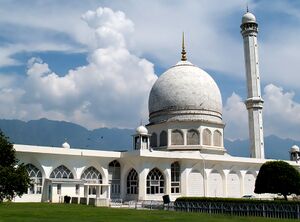Hazratbal
 | |
| General Information | |
|---|---|
| Established | 1005/1596 |
| Type | Shrine: The place where a strand of hair attributed to the Prophet (s) is kept |
| Location | Srinagar, Kashmir |
| Coordinates | 34°7′45″N 74°50′32″E / 34.12917°N 74.84222°E |
| Related events | Conflicts and protests was held all over Kashmir and some Indian cities following the disappearance of the sacred hair for 9 days |
| Architecture | |
| Style | Mongolian and Kashmiri |
| Renovation | 1968 |
Ḥaḍratbal Shrine (Urdu: حضرت بل) is the most important shrine of Muslims in Kashmir where it is claimed that a strand of Prophet Muhammad's (s) hair is kept. As it is narrated, in the first years of the 11th/16th century this box of hair of Prophet (s) was brought to India by a servant of Prophet (s). It is displayed every year for people in special annual ceremonies like, birthday of Prophet Muhammad (s) and the night of Mi'raj. A large number of people come and visit Hazratbal and the sacred relic. Hazratbal is located in the western side of Dal River in Srinagar.
From Muslims' perspective in Kashmir, Hazratbal is a divine link between Prophet Muhammad (s) and his followers. When the sacred hair was lost for nine days, there were conflict and protests all over Kashmir and some cities of India which represents the significance and holiness of the relic in political and social life of Muslims in Kashmir.
Name
According to Kashmiri language the word "Bal" means river bank, and as this place is located on the bank of Dal River, it is assumed the name Bal is originated from the place. On the other hand, Bal means hair in Kashmiri language.
History
The first narration on moving of the supposed hair of Prophet Muhammad (s) from Medina to India goes back to the early years of the 11th/16th century. It is said in 1005/1596 in the time of Ibrahim 'Adil Shah II, Mir Muhammad Saleh Hamadani brought some strands of hair of Prophet Muhammad (s) from Medina to Bijapur which drew attention of Sultan.
In the time of Shah Jahan (r. 1037/1627-8 – 1068/1657-8) Sayyid 'Abdullah Bijapuri a servant of the Shrine of Prophet Muhammad (s) brought the hair attributed to Prophet Muhammad (s) from Hijaz to Bijapur in India. The information on precision of attributing the hair to Prophet Muhammad (s) and the exact time when it was brought to India is contrary.
In 1111/1699-1700 in the time of Aurangzeb, Nur-ud-Din Eshai a businessman from Kashmir bought the hair (known as the sacred hair), but he passed away on his way back home. Then his body as well as the sacred hair was moved to Srinagar.
Hazratbal Shrine
At first the hair was put in mausoleum of Naqshband, but the place was not big enough to contain large crowd of people. As a result, the Mongol ruler, as recommended by the grand figures of the city, ordered to move the sacred hair to Sadiqabad garden and the building of the garden was dedicated to pilgrims who visited the sacred hair; later it was called Hazratbal.
The early architecture of the building of Sadiqabad was built by Mongol and Kashmir architectural style. The building was expanded as large number of pilgrims came to visit the sacred hair and the place. Later a mosque was built on the west side and a large monastery was built in the east side of the garden. Since 1322 sh/1943-4 Hazratbal is administrated by Wakf Board. The current building is covered with white marbles; its design is inspired by al-masjid al-Nabawi in Medina. Shaykh 'Abd Allah, the prime minister of the time, put Wakf Board in charge of building the current construction of the place.
Disappearance for Nine Days
The sacred hair was disappeared on Sha'ban 10, 1383/27th December. 1963 and it was brought back after nine days. It is said conflicts and protests was held all over Kashmir and some cities of India which represents the significance of the sacred hair in political and social life of Muslims in Kashmir.
Spiritual Status
Muslims of Kashmir regard Hazratbal as a link between divine life of Prophet Muhammad (s) and his followers. The significance and status of the sacred hair among Muslims is shown in their local poems and music. Visiting Hazratbal is regarded at the same level of visiting al-Masjid al-Nabawi; as a result it is called as the second Medina.
In Public Ceremonies
The sacred hair is kept in a gloss box and it is shown to people publicly on special occasions such as annual celebrations including birthday of Prophet Muhammad (s) and the night of Mi'raj when it is visited by a large number of people who come from all over the Kashmir to Srinagar. A special person is appointed in charge of displaying the sacred hair.
Tabarruk
Those who come to visit Hazratbal and the sacred hair seek Tabarruk (blessing). They come to ask for blessing and have their problems resolved. They also dedicate some money and worthy possessions to Hazratbal. People touch the sacred hair as a way of asking for blessing.
Social Interactions in Hazratbal
The ceremony of displaying the sacred hair is held significantly. Meanwhile local people of Kashmir have considerable social and economic interactions people of other regions. A huge shopping mall is organized near Hazratbal and people bring their goods to make trades.
References
- The material for writing this article is mainly taken from حضرت بال in Farsi WikiShia.
